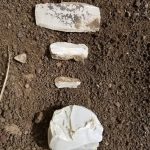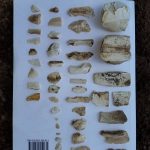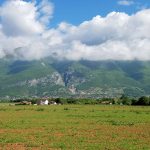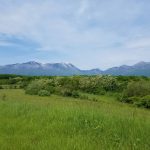In some parts of Kosovo, scattered right on the surface of the soil are numerous artifacts, some of which date back as far as 8,000 years. Local archaeologists know there are dozens of archaeological sites somewhere in the area, but no one is sure exactly where they are.
For the past two summers, UConn graduate student Elic Weitzel has traveled to Kosovo to survey for ancient artifacts to help pinpoint the locations of these sites, so that more can be learned about the area’s rich – and oftentimes fraught – history.
The region is thought to have been inhabited for nearly 10,000 years. Weitzel says the archaeological records of Kosovo and other Balkan countries reflect conflict and conquests – with unrest continuing even after the recent wars and Kosovo’s declaration of independence in 2008 – but the region was also an area that the first people to introduce farming to Europe would have traveled through. As a scholar of early farming, this research will expand his expertise in the field, as well as hone his research skills as he helps to identify, date, and reconstruct the past.

A prehistoric stone axe, possibly Neolithic, found north of Banja e Pejës. Through analysis of the artifacts found, the researchers hope to identify key archaeological sites for future study. (Elic Weitzel/UConn Photo)
3
A prehistoric stone axe, possibly Neolithic, found north of Banja e Pejës. Through analysis of the artifacts found, the researchers hope to identify key archaeological sites for future study. (Elic Weitzel/UConn Photo)

Prehistoric stone tools, likely from the Neolithic period. The artifacts found by the researchers are being stored in the capital Prishtina, with the Kosova Institute of Archaeology. (Elic Weitzel/UConn Photo)
16
Prehistoric stone tools, likely from the Neolithic period. The artifacts found by the researchers are being stored in the capital Prishtina, with the Kosova Institute of Archaeology. (Elic Weitzel/UConn Photo)

Prehistoric stone tools, likely from the Neolithic period. (Elic Weitzel/UConn Photo)
Weitzel7
Prehistoric stone tools, likely from the Neolithic period. (Elic Weitzel/UConn Photo)

Prehistoric stone tools (likely from the Neolithic period) from all stages of the tool manufacturing process. (Elic Weitzel/UConn Photo)
Weitzel6
Prehistoric stone tools (likely from the Neolithic period) from all stages of the tool manufacturing process. (Elic Weitzel/UConn Photo)

Prehistoric ceramics, mostly from the Bronze Age, from various sites near Peja. (Elic Weitzel/UConn Photo)
2
Prehistoric ceramics, mostly from the Bronze Age, from various sites near Peja. (Elic Weitzel/UConn Photo)

Roman and Medieval period ceramics from various sites near Peja. (Elic Weitzel/UConn Photo)
1
Roman and Medieval period ceramics from various sites near Peja. (Elic Weitzel/UConn Photo)

A Late Roman monastery (4th-6th century CE) at the foot of the Albanian Alps. (Elic Weitzel/UConn Photo)
4
A Late Roman monastery (4th-6th century CE) at the foot of the Albanian Alps. (Elic Weitzel/UConn Photo)

Surveyed fields near Banja e Pejës in Western Kosova. Through the surveys, the researchers hope to identify key archaeological sites. (Elic Weitzel/UConn Photo)
Weitzel8
Surveyed fields near Banja e Pejës in Western Kosova. Through the surveys, the researchers hope to identify key archaeological sites. (Elic Weitzel/UConn Photo)

Surveyed fields near Banja e Pejës in Western Kosova. Artifacts are brought to the surface through the freezing and thawing of the soil, and by plowing, which also moves objects around. (Elic Weitzel/UConn Photo)
9
Surveyed fields near Banja e Pejës in Western Kosova. Artifacts are brought to the surface through the freezing and thawing of the soil, and by plowing, which also moves objects around. (Elic Weitzel/UConn Photo)

Surveyed fields near Banja e Pejës in Western Kosova. (Elic Weitzel/UConn Photo)
Weitzel10
Surveyed fields near Banja e Pejës in Western Kosova. (Elic Weitzel/UConn Photo)

A view of Rugova Canyon west of Peja, Kosova. The canyon has been used as a way to access the high mountains for thousands of years. (Elic Weitzel/UConn Photo)
11
A view of Rugova Canyon west of Peja, Kosova. The canyon has been used as a way to access the high mountains for thousands of years. (Elic Weitzel/UConn Photo)

A Kosovo Liberation Army flag in Sudenicë, Kosova, where a Kosovo Liberation Army base existed during the Kosovo War. Weitzel says the recent war resulted in damage to some archaeological sites, particularly when one side viewed the site as the cultural heritage of the other. (Elic Weitzel/UConn Photo)
12
A Kosovo Liberation Army flag in Sudenicë, Kosova, where a Kosovo Liberation Army base existed during the Kosovo War. Weitzel says the recent war resulted in damage to some archaeological sites, particularly when one side viewed the site as the cultural heritage of the other. (Elic Weitzel/UConn Photo)

Some of the RAPID-K crew hiked to the top of a mountain near Bogë, Kosova, on their time off. Elic Weitzel is on the far right. (Photo by Dukagjin Mehmetaj)
13
Some of the RAPID-K crew hiked to the top of a mountain near Bogë, Kosova, on their time off. Elic Weitzel is on the far right. (Photo by Dukagjin Mehmetaj)

Elic Weitzel (center) takes a break from work to enjoy some baklava with members of the crew near Banja e Pejës on Bajram (Eid al-Fitr). (Photo by Zhaneta Gjyshja)
15
Elic Weitzel (center) takes a break from work to enjoy some baklava with members of the crew near Banja e Pejës on Bajram (Eid al-Fitr). (Photo by Zhaneta Gjyshja)

The crew of RAPID-K 2019, wearing project t-shirts, in Peja, Kosova. Peja is the third-largest city in the country. (Photo by Sylvia Deskaj Galaty)
17
The crew of RAPID-K 2019, wearing project t-shirts, in Peja, Kosova. Peja is the third-largest city in the country. (Photo by Sylvia Deskaj Galaty)
The UConn graduate student is part of a team led by Mike and Sylvia Galaty from the University of Michigan and Haxhi Mehmetaj from the Kosova Institute of Archaeology. The researchers are in the midst of a multiyear survey project in Kosovo called RAPID-K: Regional Archaeology in the Peja and Istog Districts of Kosova. (Kosovo is known as Kosova among the country’s majority Albanian population. Peja and Istog are cities in the western part of the country.)
Weitzel says he has always wanted to work in interesting and distant locations, and has a keen interest in the archaeology of Albania and Western Balkans. On a whim, he Googled the subject and came across Mike Galaty, who at that time was just launching the project.
“I thought it was worth a shot,” he recalls. “I emailed to volunteer, and he said he’d be able to bring me along.”
He says archaeology is very relevant in the region, as it is a contested territory and archaeology is one way that people lay claim to land.
Weitzel adds that the project is not only interesting from an archaeological point of view, but also gives the researchers an opportunity to interact with local people and experience the culture firsthand.
He says many of the surveys take place in people’s gardens, fields, or yards, but instead of the occupants telling them to get off their property, they often welcome the researchers in for coffee and snacks. When they explain what they are surveying for – shards of stone, pottery, or stone tools – local residents are surprised at their interest in such everyday objects.
In the coming years, Weitzel hopes to continue with the surveys and also with the eventual analysis of what has been found.


















